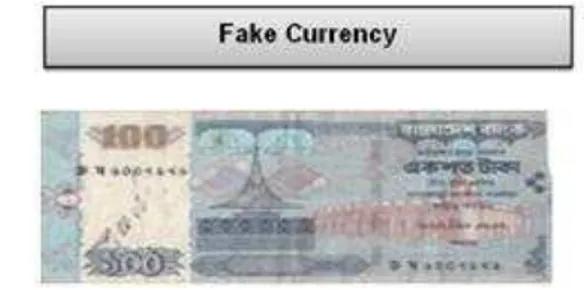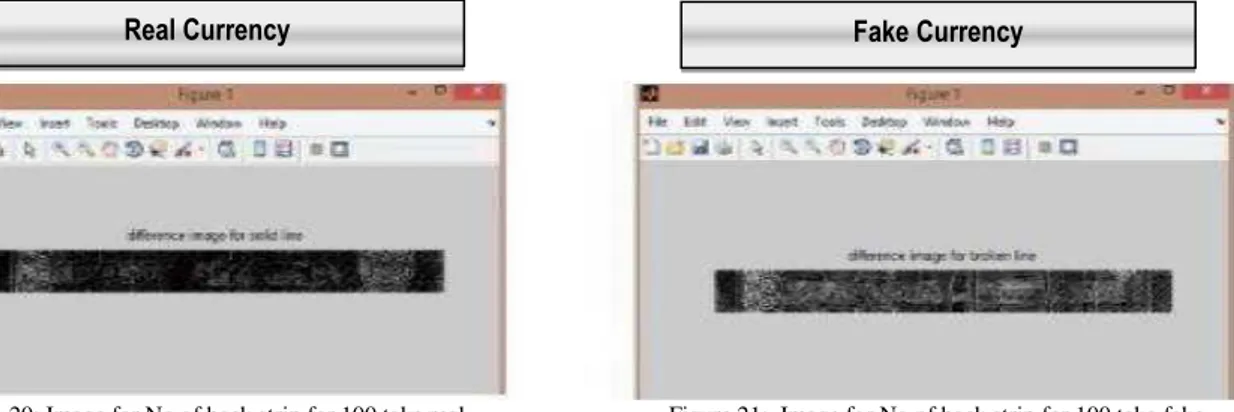American Journal of Engineering Research (AJER)
American Journal of Engineering Research (AJER)
e-ISSN: 2320-0847 p-ISSN : 2320-0936
Volume-4, Issue-11, pp-26-32
www.ajer.org
Research Paper Open Access
Currency Recognition System Using Image Processing
S. M. Saifullah
1, AnikaRahmanAnanna
2, Md. Shakhawat Hossain
3, Md. Jaouad
Hossain
4,Md. SaniatRahman Zishan
51, 2, 3, 4, 5
(Electrical and Electronic Engineering, American International University-Bangladesh, Bangladesh)
ABSTRACT
:
In the last few years a great technological advances in color printing, duplicating and scanning, counterfeiting problems have become more serious. In past only authorized printing house has the ability to make currency paper, but now a days it is possible for anyone to print fake bank note with the help of modern technology such as computer, laser printer. Fake notes are burning questions in almost every country. Like others country Bangladesh has also hit really heard and has become a very acute problem. Therefore there is a need to design a currency recognition system that can easily make a difference between real and fake banknote and the process will time consuming. Our system describes an approach for verification of Bangladeshi currency banknotes. The currency will be verified by using image processing techniques. The approach consists of a number of components including image processing, image segmentation, feature extraction, comparing images. The system is designed by MATLAB. Image processing involves changing the nature of an image in order to improve its pictorial information for human interpretation. The image processing software is a collection of functions that extends the capability of the MATLAB numeric computing environment. The result will be whether currency is real or fake.Keywords
-Image pre-processing, Conversion, segmentation, Feature extraction, Currency recognition.I.
INTRODUCTION
It`s very difficult for the people to differentiate the real and the fake currencies. In Bangladesh, fake notes are available. In fact, the bank workers cannot distinguish the difference between the real and the fake currencies because they check the notes in bare eyes and so their perception can be wrong sometimes. For this ordinary people can be cheated anytime. And also this causes an increment of doing many criminal offences. To solve this major problem, a system is developed that will detect the currency whether it is fake or real. For example, Bangladeshi currency is used for analysis.
The system presents the image processing system containing all the necessary processes such as image scanning and reading, image pre-processing, segmentation, feature extraction etc. along with a code that is done in MATLAB software. So this system is represented as an identifier of the fake and real currencies.MATLAB is the computational tool of choice for research development and analysis. The image formats supported by BMP, HDF, JPEG, PCX, TIFF, XWV, PNG and so on.
II.
METHODOLOGY OF RECOGNIZINGB
ANGLADESHI CURRENCYFigure 1: Block Diagram of the system.
Image Scanning and Reading:
The image we get from scanner is formatted by JPEG. JPEG (Joint Photographic Experts Group) is a standard for destructive or loss compromising for digital images. When you save the image as JPEG, the image will lose some information, and this cannot be recovered. And after that the JPEG image is read using MATLAB code. [1]
A.
Image Smoothing:
While performing image transfers, some noise may appear on the image. Removing the noise is an important step when image processing is being performed. However noise may affect segmentation and pattern matching. Mask values can be used to determine the degree of smoothening and to reduce noise. Higher is the size of mask, more is the smoothening. [2]
B.
Conversions:
There are two types of conversion happened in our system. One is Gray scale and other is Binary scale conversions.
Gray Scale Conversion:
Binary Scale Conversion:
A binary image is a digital image that has only two possible values for each pixel. Typically the two colors used for a binary image are black and white. We use binary conversion for proper segmentation. [4]
C.
Image segmentation:
The result of image segmentation is a set of segments that collectively cover the entire image, or a set of contours extracted from the image. Each of the pixels in a region is similar with respect to some characteristic or computed property, such as color, intensity, or texture. Adjacent regions are significantly different with respect to the same characteristic. [5]
D.
Feature Extraction:
The feature extraction includes the extraction of features of serial numbers of currency notes. During this process, the dimensionality of data was reduced. Feature extraction or selection was a pivotal procedure considerably for currency recognition, which effects on design and performance of the classifier intensively. Basically, at first instance, people may not pay attention to the details and exact characteristics of banknotes for their recognition, rather they consider the common characteristics of banknotes such as the size, the background color (the basic color), and texture present on the banknotes. [6]
E.
Pattern Matching:
Pattern Matching is the process after segmentation where the difference between the real and the fake notes can be identified in an accurate way.
III.
SIMULATIONS AND ANALYSIS OF THE RESULTSMATLAB simulation tool is used for image processing and for analyzing the simulated results. Analysis of the simulated results are discussed in the below sections.
A.
Scanned Image:
A digital image scan takes a similar approach to the second type of photo sensor, but instead of using one matrix for each component, it uses one array per component. A scanner is needed to scan the currency both of real and fake
.
Figure 2: Scanned RGB image for 100 taka real. Figure 3: Scanned RGB image for 100 taka fake.
B.
Read the Image Using MATLAB:
C.
Gray Scale Conversion:
After step B, the RGB image is converted to gray and then gray image.
Figure 6: Gray scale image for 100 taka real. Figure 7: Gray scale image for 100 taka fake.
D.
Segmentation for Black Line
:From the gray scale image segmented part of backlines for both real and fake currency are selected.
Figure 8: Gray segmented image for 100taka real. Figure 9: Gray segmented image for 100 taka fake.
E.
Binary Scale Image for Segmented Image:
Then binary scale image is converted from the gray scale image for the segmentation.
Figure 10: Binary Scale Image for 100 taka real. Figure 11: Binary Scale Image for 100 taka fake.
F.
Open area image:
Figure12: Open area image for 100 taka real. Figure13: Open area image for 100 taka fake.
G.
Post Analysis for Segmented Open Area Image:
Post analysis means that the segmented image is needed to be more precious. From the below figure difference between real and fake can be visually seen.
Figure 14: Open area Image for 100 taka real. Figure 15: Open area Image for 100 taka fake.
H.
Image for black line:
Figure 16: Image of black line for real 100 taka. Figure 17: Image of black line for fake 100 taka.
I.
Graph for black line:
J.
Black strip:
Every currency has some unique characteristic. Every Bangladeshi currency has black strip. And it’s one of
the unique characters of money.Image of the black strip of 100 taka is given bellow both real and fake.
Figure 20: Image for No of back strip for 100 taka real. Figure 21: Image for No of back strip for 100 taka fake.
K.
Graph for Black Strip:
The graphs of the black line for both real and fake notes are simulated by using MATLAB. The differences between real and fake notes are visible in the graph.
Figure 22: Graph for No of back strip for 100 taka real . Figure 23: Graph for No of back strip for 100 taka fake.
L.
No of Black line:
The last step is to simply count the number of black lines in each image. If there is just 1, this denotes that the bank note is fake, while if there is more than 1, this denotes that the bank note is fake.[8]
Figure 24: No of black line shown in command window.
IV.
C
ONCLUSIONThis paper discussed the currency recognition system with a digitalized image processing system. This system can work for assisting visually impaired people to correctly determine the denomination of the currency notes. It can help to distinguish the original note from counterfeit currency. If the image exhibit information loses such as surface damage, noise level, sharpness issues and so on, the recognition may fail and the user has to do the processing again. The system had beenprogrammed by using MATLAB and it will include a user-friendly interface.
Real Currency Fake Currency
V.
Acknowledgements
First of all, we would like to thank Almighty Allah for completing the paper successfully. We would like to thank our beloved elder brothers Md. Moidul Islam, and Md. Mostafizur Rahman, who encouraged and supported us throughout to produce a good research and also a good paper.
R
EFERENCES[1] Math Works Website Available at http://www.mathworks.com/products/scan/image/
[2] Proakis and Manolakis. Digital Signal Processing (4th ed.) [Online].Available:http:// www.code.google.com
[3] RubeenaMirza, Vinti Nanda, “Paper Currency Verification System Based on Characteristic Extraction Using Image Processing”, IJEAT, February 2012, pp 2249 – 8958
[4] KishanChakraborty, Jordan Basumatary,DebasmitaDasgupta, Jagadish Chandra Kalita,,Subra Mukherjee , “RECENT DEVELOPMENTS IN PAPER CURRENCY RECOGNITION”SYSTEM, IJRET, 2012, pp2321-7308
[5] (2015) mathworks website [online] Available: http://www.mathworks.com/products/Security
[6] Yaojia Wang Siyuan Lin, Siyuan Lin, “a currency recognition system,” International Journal of Engineering and Advanced Technology (IJEAT), February 2012. Pp 2249 – 8958.
[7] Amol A. Shirsath1 and S. D. Bharkad“IJRET “A currency recognition system” International Journal of Research in Engineering and Technology ,2013 pp 2321-7308.




